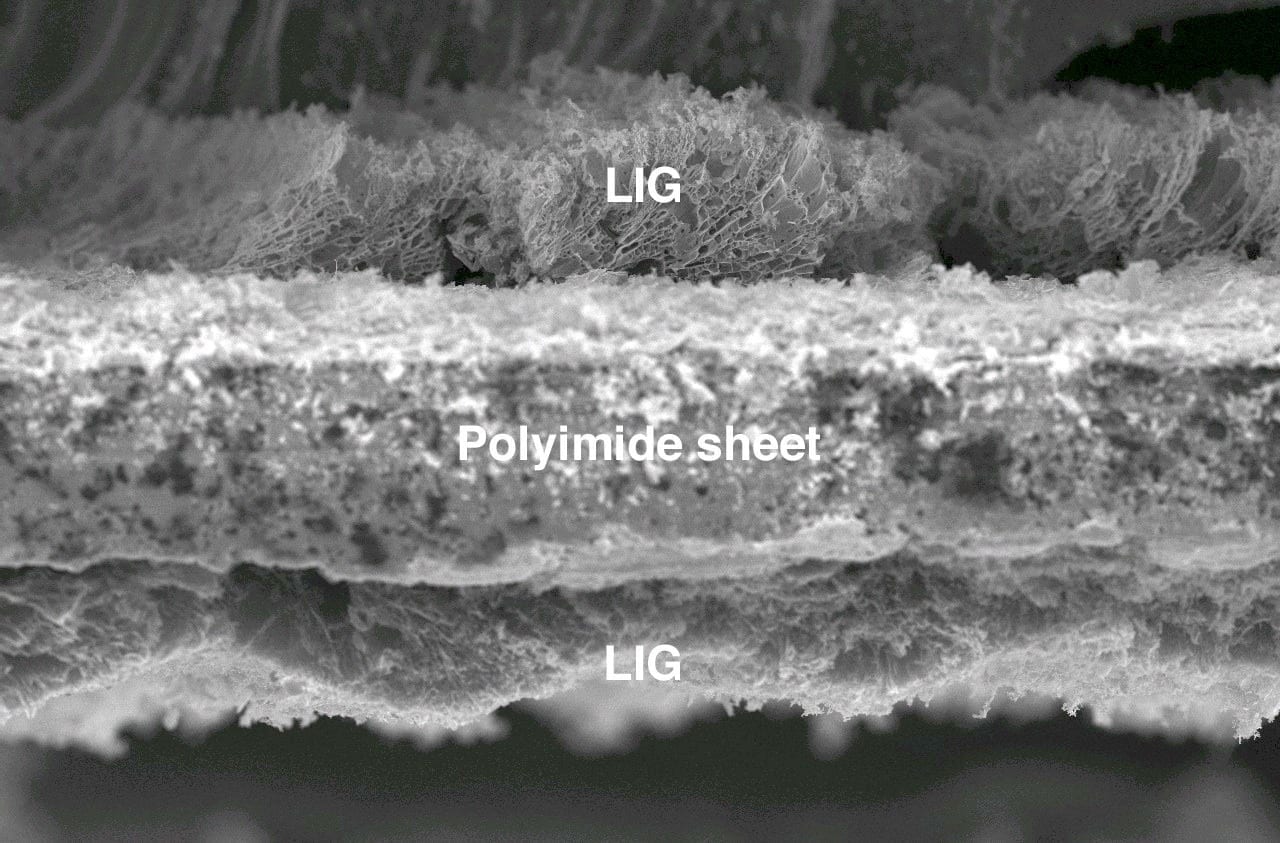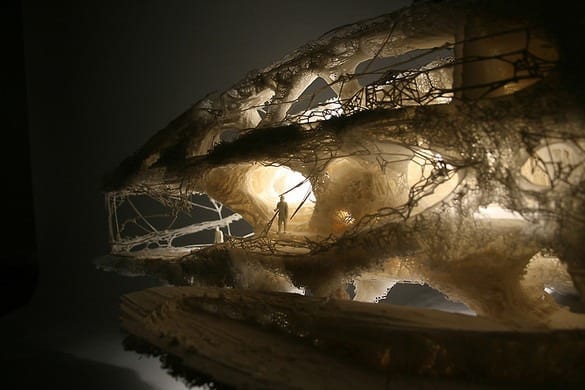
ICFO scientists show that graphene is highly efficient in converting light to electricity
Bottles, packaging, furniture, car parts… all made of plastic. Today we find it difficult to imagine our lives without this key material that revolutionized technology over the last century. There is wide-spread optimism in the scientific community that graphene will provide similar paradigm shifting advances in the decades to come. Mobile phones that fold, transparent and flexible solar panels, extra thin computers… the list of potential applications is endless. Scientists, industries and the European Commission are so convinced of the potential of graphene to revolutionize the world economy that they promise an injection of €1.000 million in graphene research.
The most recent discovery published in Nature Physics and made by researchers at the Institute of Photonic Science (ICFO), in collaboration with Massachusetts Institute of Technology, USA, Max Planck Institute for Polymer Research, Germany, and Graphenea S.L. Donostia-San Sebastian, Spain, demonstrate that graphene is able to convert a single photon that it absorbs into multiple electrons that could drive electric current (excited electrons) – a very promising discovery that makes graphene an important alternative material for light detection and harvesting technologies, now based on conventional semiconductors like silicon.
“In most materials, one absorbed photon generates one electron, but in the case of graphene, we have seen that one absorbed photon is able to produce many excited electrons, and therefore generate larger electrical signals” explains Frank Koppens, group leader at ICFO. This feature makes graphene an ideal building block for any device that relies on converting light into electricity. In particular, it enables efficient light detectors and potentially also solar cells that can harvest light energy from the full solar spectrum with lower loss.
The experiment consisted in sending a known number of photons with different energies (different colors) onto a monolayer of graphene. “We have seen that high energy photons (e.g. violet) are converted into a larger number of excited electrons than low energy photons (e.g. infrared). The observed relation between the photon energy and the number of generated excited electrons shows that graphene converts light into electricity with very high efficiency. Even though it was already speculated that graphene holds potential for light-to-electricity conversion, it now turns out that it is even more suitable than expected!” explains Tielrooij, researcher at ICFO.
The Latest Bing News on:
Converting light to electricity
- Siemens Energy reports strong second quarter results and raises outlook for fiscal year 2024on May 8, 2024 at 5:53 am
Siemens Energy has announced its earnings release for the second quarter of fiscal year 2024, show-casing robust performance amidst a positive market environment.
- Ryder Examines Economic Impacts of Converting to Commercial Electric Vehicles (EV) in Current Marketon May 8, 2024 at 3:55 am
Ryder releases quantitative analysis of potential economic impacts of converting commercial diesel vehicles to electric vehicles in today’s market.
- Company receives approval to install fully submerged wave energy converter to generate clean power: 'This is an exciting green light'on May 7, 2024 at 9:00 pm
"We keep taking important steps towards being grid-connected and generating renewable electricity from waves." Company receives approval to install fully submerged wave energy converter to generate ...
- Hitachi Energy to provide HVDC tech for huge Western transmission projecton May 7, 2024 at 3:26 pm
The long-term agreement will provide service solutions for the SunZia Transmission HVDC link, which is currently under construction.
- Light Triggers Water Evaporation, No Heat Requiredon May 7, 2024 at 11:47 am
Though water itself does not absorb much light, and neither does the hydrogel material itself, when the two combine they become strong absorbers, Chen says. That allows the material to harness the ...
- Ryvid Outset launched as $5,995 US-built electric motorcycleon May 7, 2024 at 7:02 am
Ryvid, the Southern California-based manufacturer of the popular Ryvid Anthem electric motorcycle, has just launched its second model based ...
- Hitachi Energy supports long-term operation of largest HVDC-connected wind energy project in U.S.on May 7, 2024 at 1:06 am
renewable electricity to provide power to approximately three million Americans 3. The HVDC link will efficiently transmit up to 3,000 MW of this power west to Arizona. The HVDC Light system will be ...
- Sprawling SunZia Project Pursues Lofty Energy Goalson May 6, 2024 at 4:59 pm
Across central New Mexico and southern Arizona, the largest U.S. renewable energy infrastructure project is taking shape ... Pattern decided to source turbines from two suppliers to mitigate risk in ...
- The Evolution Of Solar Energy: How Solar Panels Have Changed Over The Yearson May 5, 2024 at 9:30 am
The evolution of solar is a long story that hasn't come close to finishing. Here's how solar panels have changed and evolved over the years.
- Shining a light on energy sustainability with synthetic methaneon May 1, 2024 at 10:43 pm
By producing synthetic methane using the sun, this team of researchers is working towards closing the carbon loop.Methane, the main ...
The Latest Google Headlines on:
Converting light to electricity
[google_news title=”” keyword=”converting light to electricity” num_posts=”10″ blurb_length=”0″ show_thumb=”left”] [/vc_column_text]The Latest Bing News on:
Graphene
- Finnlines rolls out fuel and emissions reducing hull coatingon May 8, 2024 at 9:41 am
Finnlines is to roll out a graphene-based hard foul release hull coating across its ro-ro and ro-pax fleets following a seven per cent reduction in fuel consumption and emissions on four of its ...
- Graphene Manufacturing Group Announces Closing of $3.47M Marketed Offering, Including Exercise In Full of the Over-Allotment Optionon May 8, 2024 at 2:52 am
BRISBANE, Australia, May 07, 2024 (GLOBE NEWSWIRE) -- Graphene Manufacturing Group Ltd. (TSX-V: GMG) (“GMG” or the “Company”) is pleased to announce that the Company has closed its previously ...
- GLOBAL: Finnlines opts for GIT Coatings’ graphene-based hard foul release hull coating for Ro-Ro, Ro-Pax fleetson May 8, 2024 at 2:21 am
Bunkerspot provides news, in-depth analysis, expert comment and price indications for the global marine fuels industry ...
- Bio-inspired materials' potential for efficient mass transfer boosted by a new twist on a century-old theoryon May 7, 2024 at 2:31 pm
The natural vein structure found within leaves -- which has inspired the structural design of porous materials that can maximize mass transfer -- could unlock improvements in energy storage, catalysis ...
- Wonder Material 'More Remarkable' Than Graphene Has Medical Potentialon May 7, 2024 at 8:55 am
Borophene is already thinner and more conductive than graphene, and scientists have altered it to make it even more special.
- Finnlines Adopts Graphene-based Hard Foul Release Hull Coatingon May 7, 2024 at 8:30 am
Finnlines has turned to a innovative graphene-based hard foul release hull coating to reduce fuel consumption and emissions ...
- Closing Bell: Black Swan Graphene Inc up on Monday (SWAN)on May 6, 2024 at 9:44 pm
Black Swan Graphene Inc opened trading today at $0.12 and closed at $0.12. Intraday prices ranged from $0.12 to $0.12. The price advanced 4.17% from the previous day's close of $0.12. Today across ...
- 'Better than graphene' material development may improve implantable technologyon May 6, 2024 at 7:01 am
Move over, graphene. There's a new, improved two-dimensional material in the lab. Borophene, the atomically thin version of boron first synthesized in 2015, is more conductive, thinner, lighter, ...
- Wigner crystal appears in bilayer grapheneon May 2, 2024 at 1:30 am
Researchers at Princeton University in the US say they have made the first direct observation of a Wigner crystal – a structure consisting solely of electrons arranged in a lattice-like configuration.
- Graphene Manufacturing Group Ltd GMGon May 1, 2024 at 5:00 pm
Morningstar Quantitative Ratings for Stocks are generated using an algorithm that compares companies that are not under analyst coverage to peer companies that do receive analyst-driven ratings ...
The Latest Google Headlines on:
Graphene
[google_news title=”” keyword=”graphene” num_posts=”10″ blurb_length=”0″ show_thumb=”left”]











